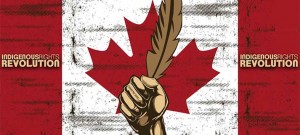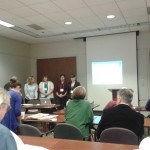We invite Native Americans and First Nations people who are learning and revitalizing their languages, and graduate students, faculty and other scholars who specialize in Linguistics (preferably in Native American or First Nations languages) to apply to participate in the Breath of Life Archival Institute for Indigenous Languages (BoL).BoL is designed to promote active collaboration among people with a wide range of perspectives about language and culture, including technical linguistic knowledge and cultural expertise. Participants will be grouped into research teams, based on language, made up of linguists and Native community language researchers. Team members will actively work together, mentor one another, and share their expertise throughout the program and beyond.The research teams will explore archives and museum collections at the Library of Congress and the Smithsonian Institution, with morning workshops on linguistics, language teaching and learning, archival research and language revitalization held at the National Museum of the American Indian. The two weeks of study will culminate in a research project and presentation that uses archival or museum resources for linguistic research or language teaching.Beyond a general commitment to language learning from archival sources, participants must be willing and able to attend and actively participate in the entire Institute. Aside from truly unforeseen circumstances, it will not be possible to arrive late, leave early, or to skip the required workshops and events (though some workshops will be optional).Participants will stay in the dorms at George Washington University, where they can network and study together in the evenings. BoL will pay for participants’ rooms, and partially subsidize food and travel.BoL will accept 60 participants. This is a great opportunity to find and use archival materials to reclaim, learn, and teach indigenous languages, in the company of other like-minded people.The 2013 Breath of Life Institute is funded by the Documenting Endangered Languages Program of the National Science Foundation. Partners include the National Museum of Natural History, The National Museum of the American Indian, the Library of Congress, The Endangered Language Fund and Yale University.
Conference Presentations by the Mi’gmaq Research Partnership
This October was the 44th Algonquian Conference at the University of Chicago. Many of our Mi’gmaq Research Partnership members presented.
- Mike Hamilton presented “(Non-)Configurationality in M’igmaq”
- Elise McClay presented “Possessive paradigms in Mi’gmaq: alienability as syntactic proximity”
- Gretchen McCulloch presented “Slots or scope? Preverb ordering in Mi’gmaq”
- Erin Olson presented “Describing the accent system of Mi’gmaq”
- Carol Little and Elise McClay presented along with Listuguj community members Mary-Beth Wysote and Sarah Vicaire “Student perspectives on Mi’gmaq language-learning through multi-modal teaching: A community-linguistics partnership“.
- Conor Quinn presented “Listuguj Mi’gmaq: Variation and distinctive dialectal features.”
Alan Bale and Jessica Coon presented “Classifiers are for numerals, not nouns: Evidence from Mi’gmaq and Chol.” at the 43rd Northeast Linguistics Society (NELS) in New York, NY where Alan also had a poster presentation of “Agreement without AGREE: Disjunction in Mi’gmaq.”
More recently Mike and Gretchen both presented at The 2012-3 Annual Meeting of the Society for the Study of Indigenous Languages of the Americas (SSILA) in Boston, MA. Mike presented “Against Non-configurationality in Mi’gmaq” and Gretchen “Preverb Ordering in Mi’gmaq”
And stay tuned for Elise and Carol’s poster presentation of “Student perspectives on Mi’gmaq language-learning through multi-modal teaching: A community-linguistics partnership” at the University of Hawai’i’s at the 3rd International Conference on Language Documentation and Conservation on February 28th.
Idle No More and Canada’s Languages
The grassroots Idle No More movement is gaining momentum across Canada. In Listuguj, supporters have blocked and slowed highway traffic and set up blockades at the railroad tracks at Pointe-à-la-Croix to prevent freight trains from passing through. The Mi’gmaq Grand Council recently issued a letter in support of the movement, calling on Canada to respect Mi’gmaq Constitutional and treaty rights. This afternoon, the Van Horne bridge will be closed for a peaceful march, and Listuguj Chief Dean Vicaire will travel to Ottawa to meet with Stephen Harper as part of a delegation of First Nations Leaders.
Much of the discussion surrounding Idle No More focuses on the Harper Government’s policies on natural resources––and specifically on Bill C-45. But Montreal-based blogger âpihtawikosisân points out that the movement is about more than land and water rights: it is about the relationship between Canada and Indigenous peoples more generally.
How does language factor in to all of this? In 1951, 87% of Aboriginal people in Canada spoke an Aboriginal languages as their first language. By 1986 this number had dropped to 29% (Burnaby & Beaujot 1986). At current rates of decline, it is predicted that only four of what were once sixty Aboriginal languages spoken in Canada will survive into the next century (UBC 1996).
These languages have not simply fallen out of use. Rather, their decline began in large part with targeted assimilation efforts by the Canadian Government and churches, specifically in the form of Residential Schools. Residential school attendance was mandatory for Aboriginal children between 1884 and 1948, and the last school did not close until 1996. During this period, some 150,000 children were removed from their homes and forced to stop speaking their languages––often at the threat of physical violence. By forcing children to stop speaking their languages, Residential Schools attempted to take away more than just a means of communication:
If you take a language away from its culture, you take away its greetings, its curses, its praises, its laws, its literature, its songs, its riddles, its proverbs, its cures, its wisdom, its prayers. You are losing those things that essentially are the way of life, the way of thought, the way of valuing, and a particular human reality (Fishman 1996).
Though some steps towards reconciliation have been made, a lot of work is still needed to bring these languages back to their communities.
Given the importance of language to cultural identity, it is no surprise that languages have played an important role in indigenous movements worldwide. Across Canada, advances are being made by community-driven language reclamation efforts. This momentum can be seen clearly in Listuguj. In addition to the Mi’gmaq language classes and immersion program being offered at the Listuguj Education Directorate, a number of other community efforts are underway. See the links under “About this project” above to learn more about the Can-8 language-learning software and the new Master-Apprentice Program currently being piloted in Listuguj.
Aboriginal Languages Reclaimed By Native Gen Y
In this Huffington Post article, 25-year-old Clyde Tallio of British Columbia leads the reclamation of the Nuxalk language. He has been teaching Nuxalk at the community’s school for five years. He believes there is an ever increasing interest especially among the youth to learn Nuxalk.
Similar efforts have been happening with Squamish, also in BC. Finding that traditional language classes in school were not creating speakers, Dustin Rivers began hosting Language Nights. During these Language Nights, participants have an opportunity to practice and learn Squamish in a “informal, collaborative environment”.
22-year-old Dustin says: “There’s a lot of benefit in reclaiming our culture and saying for ourselves that we have problems, but we’re going to solve them and our culture and traditional values are going to lead us in finding these solutions.”
Ernesto Sirolli: Want to help someone? Shut up and listen!
Ernesto Sirolli: Want to help someone? Shut up and listen!
The above is a TED talk about why listening is extremely important when one wants to help someone. This is a very important thing to keep in mind when trying to help out!
Anishnaabemowin Circle Learning Guide
I just came across this Learning Guide for Anishinaabemowin, which is a community-driven reference book about the language created by Maya Chacaby with Alex McKay and Keren Rice.
The Kikinowaawiiyemon, or Language teaching circle guide, was created after several years of research and consultation. Key to its development was the overwhelming demand by language learners and community organizations for Anishinaabe-based language teaching tools. In essence, the Kikinowaawiiyemon is a grammar structured around Anishinaabe worldview. (pg. 17)
It has some very accessible explanations about the structure of the language, balancing traditional/cultural ways of knowing with a minimum of linguistics terminology. Some examples are the explanations of animacy (pg. 19-20 using Anishinaabe terms rather than animate and inanimate), person (pg. 24 the diagrams for 1st/2nd/3rd persons), and transitivity (pg. 28). Not all of their explanations would work for Mi’gmaq (for example the Eastern/Western hemisphere distinction between Independent and Conjunct doesn’t happen the same way, pg. 27), but I thought the examples might be interesting or useful to anyone working on grammar lessons or on the wiki.
While writing this post, I also came across another paper by Maya Chacaby “A Report on Best Practice Models for Tertiary Indigenous Language Learning” which also looks very interesting.
Reclaiming Indigenous Education through Language and Culture
APTN National News recently featured a three-part series on how the Mi’kmaq of Nova Scotia are reclaiming their education. It’s great to see how communities are providing a solid foundation for students through Indigenous language and culture programs.
To view the video clip on the APTN website, click on the following link: Mi’kmaq reclaiming what was lost through education.
Mid-November Update
It’s been pretty quiet on the blog for the last little while, but that’s not because we’re working less on the project! We’ve been working a whole lot on a big aspect of our Mi’gmaq Research Partnership: specifically, trying to get money.
This past month, we’ve been working on our application for a grant. It’s allowed us to get a good look at the different strengths and goals of this project, and we’ve begun to get very excited about the coming work! Turns out, we’re doing good work, and there are a whole lot of interesting areas for our project to grow and explore.
- LingSync application/Chrome extension. This is a really exciting application (at least, exciting for linguists) which will let us store, organise, and selectively share our language data (with encryption on all of it for the sake of our speakers’ privacy). Right now, we’re working with iLanguage on building on the existing code. On our to-do list is…
- Making a Conversation! LingSync expects people to enter data as single lines, unconnected to each other. What we’d like to do is add another level, which lets users add conversations, dialogues, and discourse so that the separate lines of data are linked to each other just like speakers connect to each other in real life.
- Mobile language-learning app. We’ve got (very rough) Android and Chrome extension prototypes for this already, and have a lot of ideas about where it’s going to go from here. The parts that we want to focus on the most are…
- its online/offline abilities, since a lot of language-learning apps work best online and have very limited offline capabilities
- its tool for also letting students build their own lessons! Most language lessons are “read-only”, and students are expected to consume what is put on their app and be satisfied with that. But what we want to do is let students create material with speakers in their lives, and tailor their app to their own needs.
- Master-Apprentice program. This is my favourite part of this project right now. It’s a wonderful opportunity for learners of Mi’gmaq to get some support and guidance, and partner one-on-one with fluent speakers. Again, get in touch with Vicky or look at an older blog post for more details about it!
Wiki update
The wiki has grown a lot since we first started it in March. There are currently 41 articles, including several overview pages (Main Page, Background, Verbs, Nouns) and several style pages (Style Guide, Glosses, How to do Citations, Wiki Gloss Extension) and many other pages that describe various aspects of the language. Thanks to everyone for your hard work on this so far!
A few summary page links that might be useful to editors/contributors: List of All Existing Pages, List of Most-Wanted Pages, Recent Changes.
But it doesn’t end here! Some of these existing pages need to have more content into them, and we have many ideas for other pages. Here’s a preliminary list — let us know in the comments if you have more ideas or can volunteer to write one of these.
- Expanding the VAI, VII, VTA, VTI pages
- Expanding “Pronouns” and “Questions”
- Mood
- Pronunciation Differences (between Mi’gmaq and English)
- Schwa
- Word Order
- Dialect Differences (varieties of Mi’gmaq)
- Medials, Finals
- Prepositions
- Adjectives/modification
This is also a reminder to everyone to check out the wiki and feel free to edit typos, sentence phrasing, explanations, make new pages, or anything else. If you don’t have an account already, you’ll need to ask me (Gretchen) or Mike to set one up for you, but this is not difficult and we are happy to do so.
Returning from the Algonquian Conference
We were well-represented at the 44th Algonquian Conference in Chicago this weekend, with a group talk by Carol, Sarah, Mary-Beth and Elise about the summer Mi’gmaq language course, in addition to individual linguistics talks by Mike, Elise, Gretchen, Erin, and Conor. For more details on the individual talks, check out the Research page, which already has abstracts but will hopefully have handouts soon.
It was a great trip and we met a lot of people. Here are some pictures!






